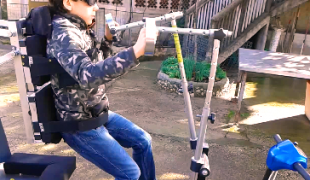- 4152
- 184
- 3
- 5
- 0
- Help Ukraine
About the solution
“The ProMove Sling is a disabled lifting sling for when you can’t take your hoist with you. It can help disabled people transfer from a wheelchair to just about anywhere.
This is an innovative disabled lifting sling that is incredibly light & portable, making it a realistic alternative when a hoist is not an option, enabling a transfer/lift that is safe, comfortable and dignified”, it says on the oficial website.
Promove Slings are a much needed product due to the fact that the only way to move a disabled person where a hoist isn’t present is by picking them up under the arms and trying to move them as carefully as possible.
Promove has a range of different slings for different people to ensure all age groups are covered and transferring with a sling is possible for all individuals who need support.
Promove offer two separate adult slings. Each sling is designed so the wheelchair user can be transferred with the support of 2-4 handles lifting them safely.
There are many benefits to Promove Slings over being lifted manually. The key ones include:
• Being transferred without being uncomfortably manhandled
• Friends and family can move you without risk of injury
• Assurance that you can be evacuated safely in an emergency
• Easy to carry in its own carry bag or stored in your rucksack
• Multiple sizes mean they are accessible to all who need them
• They provide an intermediate step for children getting used to hoisting.
Adapted from: http://livingwithdisability.info/page/4/
More info: http://www.promove.uk.com/
What about you, do you have any solutions? Please share them with the Patient Innovation community!
This solution shall not include mention to the use of drugs, chemicals or biologicals (including food); invasive devices; offensive, commercial or inherently dangerous content. This solution was not medically validated. Proceed with caution! If you have any doubts, please consult with a health professional.
DISCLAIMER: This story was written by someone who is not the author of the solution, therefore please be advised that, although it was written with the utmost respect for the innovation and the innovator, there can be some incorrect statements. If you find any errors please contact the patient Innovation team via info@patient-innovation.com
-
-
240
-
0
-
3255

Tetraplegic invents mobility device to help him stand up
MOVING IN A WHEELCHAIR: Moving using a wheelchair.
WALKING WITH A WALKING AID: Walking with a walking aid
BODY BALANCE: Maintaining body balance
Spinal Cord and Nerve Root Disorders
Paralysis
Cerebral Palsy
Neuromuscular Disorders
Cervical spinal cord injury/Tetraplegia
Assistive Daily Life Device (to help ADL)
Walking Aid (wheelchair/walker/crutches)
Assistive Technology access
Muscle cramps or spasms
Difficulty coordinating movements
Stiffness or rigidity (difficulty moving)
Paralysis of the legs and lower body
Muscle weakness
Restoring mobility
Managing Neurological Disorders
Enhancing Mental Health
Maintaining Balance and Mobility
Preventing (Vaccination, Protection, Falls, Research/Mapping)
General and Family Medicine
Neurology
Orthopedics
Israel
-
-
-
395
-
3
-
6557

I'VE PATENTED A MACHINERY THAT ALLOWS TO PHYSYCALLY IMPAIRED TO WALK :)
WALKING WITH A WALKING AID: Walking with a walking aid
WALKING: Walking
MOVING IN A WHEELCHAIR: Moving using a wheelchair.
Muscular Dystrophy
Muscle Tone Abnormalities
Brain Injury (Abscess, Brain Barrier Defect, Brain Contusion, Brain Hemorrhage, Brain Edema)
Neuromuscular Disorders
Cerebral Palsy
Walking Aid (wheelchair/walker/crutches)
Assistive Daily Life Device (to help ADL)
Difficulty coordinating movements
Stiffness or rigidity (difficulty moving)
Paralysis of the legs and lower body
Muscle weakness
Restoring mobility
Managing Neurological Disorders
Preventing (Vaccination, Protection, Falls, Research/Mapping)
General and Family Medicine
Medical Genetics
Neurology
Orthopedics
Pediatrics
Italy
-
-
-
201
-
0
-
3246

Ripchair – wheelchair to go anywhere
MOVING IN A WHEELCHAIR: Moving using a wheelchair.
BODY BALANCE: Maintaining body balance
Traveling
Spinal Cord and Nerve Root Disorders
Paralysis
Cervical spinal cord injury/Tetraplegia
Assistive Daily Life Device (to help ADL)
Walking Aid (wheelchair/walker/crutches)
Gait abnormalities (e.g., walking difficulties, unsteady gait)
Muscle cramps or spasms
Difficulty coordinating movements
Stiffness or rigidity (difficulty moving)
Paralysis of the legs and lower body
Muscle weakness
Loss of balance
Cognitive impairment
Numbness or tingling in the extremities
Depression or anxiety
Promoting inclusivity and social integration
Maintaining Balance and Mobility
Preventing (Vaccination, Protection, Falls, Research/Mapping)
General and Family Medicine
Neurology
Neurosurgery
Orthopedics
United States
-
 en
en